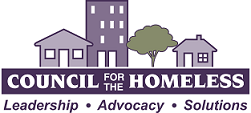By Siobhana McEwen, Council for the Homeless
This blog was originally published in the Opinion section of The Columbian on August 8, 2021.
 Two recent articles in The Columbian present an interesting and disturbing juxtaposition to each other. One, heralding the opening of a waterfront tower describes beautifully designed, immaculately constructed condominiums, complete with luxury standard touches and rent costs ranging from $2,250 to more than $5,000 per month. The other, detailing the soaring rent prices that many thousands in our community are currently facing. Could these two stories both be set in Clark County?
Two recent articles in The Columbian present an interesting and disturbing juxtaposition to each other. One, heralding the opening of a waterfront tower describes beautifully designed, immaculately constructed condominiums, complete with luxury standard touches and rent costs ranging from $2,250 to more than $5,000 per month. The other, detailing the soaring rent prices that many thousands in our community are currently facing. Could these two stories both be set in Clark County?
Last month, the National Low Income Housing Coalition published its annual Out of Reach Report (ORR). The Report’s primary statistic of note is the Housing Wage, which demonstrates the hourly wage necessary for an individual or family to afford to pay the region’s Fair Market Rent, a number set by the U.S. Department of Housing and Urban Development (HUD), without paying more than 30% of their income towards housing. According to industry standards, a rental unit is affordable if the tenant is paying 30% or less of their gross income.
For 2021, HUD’s Fair Market Rent for a one-bedroom apartment in Clark County is $1,331, and according to the ORR, an individual living here and working a 40-hour work week would need to make $25.60 per hour to be able to afford a one-bedroom at 30% of their income. That’s nearly twice the minimum wage, and doesn’t even begin to address the inflated and necessary costs of child care, health care, transportation, student loans and/or other significant expenses.
This data paints a picture of who is most impacted by these housing disparities: average, everyday people. Working-class families. Students at Clark College and WSU-V. Front-line service workers. Our elders and people with disabilities, who are stuck on a fixed income. Our Black and brown neighbors, who face significant barriers to accessing care and support because antiquated, racially-driven laws and policies that continue to impact the vitality and growth of certain neighborhoods. People who are working, studying, and parenting around the clock, staying up at night, figuring out how to stretch their paychecks through the end of the month. And, of course, these are the same individuals and families who have been hardest hit by COVID.
Clark County and its jurisdictions are experiencing unprecedented population growth. According to WA State Office of Financial Management, 4,900 new residents moved to Vancouver last year. Camas,
La Center, Ridgefield and Vancouver are all considered fastest growing cities in the state. With all these newcomers, creating housing that is affordable for all populations and across the county is imperative.
Despite the fact that voters in the City of Vancouver approved the Affordable Housing Fund in 2016, there is not enough affordable housing in the County. While there is no one-size-fits-all solution to the housing situation we’re facing, there are many great options. Several grassroots and community nonprofit organizations work diligently to address housing instability and to support our hard working neighbors facing housing crisis. This includes Evergreen Habitat for Humanity, Community Roots Collaborative, Second Step Housing, X-Change Recovery, Share, Housing Initiative, LLC, Vancouver Affordable Housing and Columbia Non-Profit Housing, to name a few. Please join in the efforts to increase affordable housing throughout Clark County by continuing to support the City of Vancouver Affordable Housing Fund and encouraging jurisdictions in Clark County to diversify their housing options. Because everyone should have an opportunity to live in a safe, stable, affordable home.
